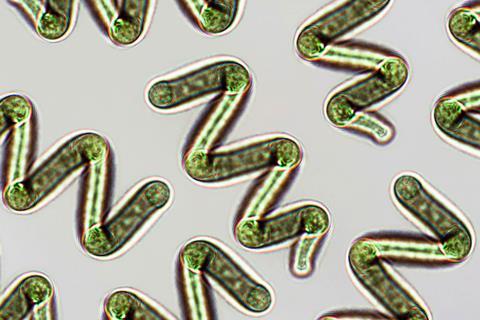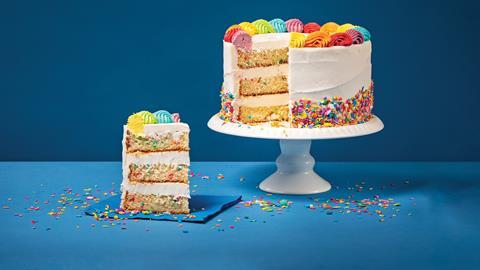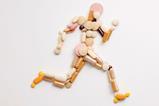What causes colours to bleed in baked sprinkles? And what happened to blue Smarties?
There’s nothing worse than runny sprinkles in your Funfetti™ cake. You know Funfetti cake, right? A delicious, fluffy vanilla sponge with sprinkles baked in. The problem is in the UK and Europe it’s harder than in the US to find sprinkles you can bake without the colours bleeding and fading. This is due to stricter regulations associated with the artificial colours in them. So, our sprinkle cakes can end up looking a little lacklustre.
It’s a problem that Rich Myers knows only too well. Based in Leeds, the British baker was a big fan of US sprinkles, until Trading Standards got involved in 2021 and the story (forever after known as #sprinklegate) blew up on the internet. According to Rich, ‘We were investigated by Trading Standards. [The sprinkles] were confiscated. It went viral.’ The issue was that when West Yorkshire Trading Standards tested the foreign sprinkles in their lab, they were found to contain higher levels of certain artificial food colourings than were allowed under UK law, as well as the banned red colourant, erythrosine (E127).
Following #sprinklegate, Rich embarked on a quest for legal, bake-stable sprinkles that wouldn’t spoil his cakes with colours that ‘just disappeared’. However, it’s not just sprinkles that are affected by problems associated with the differing regulations for food colourings. In countries where certain colourant chemicals are tightly regulated, lots of foods can end up looking different. The problem can be particularly apparent with sweet treats, though, as bakers and confectioners often rely on colourings to achieve their bright and attractive colours.
Sweet swaps
So, what makes some food colourings brighter and more bakeable than others? As food scientist Maria Corradini, from the University of Guelph in Ontario, Canada, explains, it’s all to do with the stability of the chemicals – how easily they break down at high temperatures (such as in the oven) or under UV light, for instance. Synthetic or artificial colours made in the lab tend to be more stable than those from natural sources. And since many companies are now switching to natural colours to satisfy food regulations, as well as consumer concerns, the colours can be noticeably weaker than in the past.
Take M&M’s. ‘The current M&M’s don’t have the same brightness [as the old ones],’ Maria says. ‘And if you left the [old] synthetic ones on your counter for, I don’t know, 20 days, they would still be bright and shiny.’ Whereas the new, naturally coloured versions fade much faster.
In your class
Food colourings, much like inks, are made of a mixture of different colours. These colours are water-soluble, so can be a fun way to investigate separation using chromatography techniques. This gives an engaging and colourful alternative to separating felt tip pens in the science classroom and learners will need to practise techniques that need a steady hand to create a small spot of the dissolved colouring on the filter paper.
Sprinkles are just another example where substituting with natural colourants, as we do in the UK, tends to weaken their hue – which is why Rich preferred his American sprinkles. He’s since worked with a sprinkles manufacturer in Costa Rica to create bright, American-style, bakeable sprinkles that are compliant with UK laws. It has, however, involved doing the opposite to what most sweet manufacturers have been doing: replacing some of the natural colours with (legal) artificial ones. ‘I can’t get too much into the specifics,’ he says, secretively, ‘but essentially, sprinkles are made up of eight different colours. Five of them are okay as they are, but we swapped some of the ingredients [in the other three] to make them compliant. We use artificial colours, but the three that we swapped out were made using natural colours.’ He says he is now the only UK importer of these sprinkles, selling them under the brand name expen$ive.

But why are synthetic colourings coming under such scrutiny? Actually, it’s been happening for a while. Back in 2007, for example, a team of researchers from the University of Southampton identified six red, yellow and orange food colourings – some common in sweets – that they linked to possible hyperactivity in children. After this, regulations in Europe changed so that products containing these colourings had to state on the label that they may have ‘an adverse effect on activity and attention in children’.
The six colourants were: allura red (E129), carmoisine (E122) (red), ponceau 4R (E124) (red), quinoline yellow (E104), sunset yellow (E110) and tartrazine (E102) (yellow). Except for quinoline yellow, these are all chemicals known as azo dyes, some of the most common synthetic food colouring chemicals. Quinoline yellow is a type of quinophthalone, while erythrosine, the main culprit in Rich’s banned sprinkles, is a xanthene dye. Most of the so-called ‘Southampton six’ are still widely used within guidelines for acceptable daily limits. Sunset yellow, for example, is combined with browns to colour caramels and allura red is used in strawberry laces and soft drinks.
Controversial colours

Concerns surrounding artificial colours remain and it’s not just hyperactivity that’s at issue. There are also claims about other health effects, such as allergic reactions. According to Maria, the evidence for most effects is ‘super controversial’, because the studies are hard to get right – especially as some people may be more sensitive to certain chemicals than others. As far as the hyperactivity claims are concerned, she says there is a small amount of evidence suggesting that cutting out synthetic colours leads to a reduction in symptoms of attention deficit hyperactivity disorder. ‘However, who knows if it’s actually the sugar?’ she says. ‘It’s very difficult to pinpoint.’
The confusion around the safety of these chemicals has also led to confusing guidelines and regulations for their use in food. Some are banned completely in certain countries, as in the case of tartrazine in Norway and Austria, while others are only allowed in specific products. Erythrosine is banned for most uses in the UK, including sprinkles, but it can be used to maintain the colour of naturally red foods, like the glacé cherries on bakewell tarts – a fact that Rich finds ‘ridiculous’. Sometimes, to get around the differing rules, food manufacturers develop different formulations for their products in different countries. Maria says this is a common strategy and can also be used to tailor products to the preferences of consumers in particular countries.
-

Download this
Chromatography practical, for age range 11–14
Dissolve the dyes from coloured sweets before spotting them on filter paper to find out if the colourings are pure substances or a mixture of different colours with this practical activity.
Use the original practical with starter questions, written methods and follow-up questions or the scaffolded questions and adjusted method. Resources include:
Download this
Chromatography practical, for age range 11–14
Dissolve the dyes from coloured sweets before spotting them on filter paper to find out if the colourings are pure substances or a mixture of different colours with this practical activity from the Nuffield Practical Collection.
Use the original practical with starter questions, written method and follow-up questions, or the scaffolded questions and adjusted method. A set of slides is available for use in the classroom.
Download the resources from the Education in Chemistry website: rsc.li/3MPZ1jh
Safety concerns and regulatory issues around artificial colours have persuaded some manufacturers to quit artificial colours altogether, despite the fact that they are usually cheaper. In 2016, M&M’s manufacturer Mars pledged to swap out all the artificial colours in its products for natural alternatives – although it has since changed tack, claiming that for sweets, its customers aren’t as bothered about whether the colours are natural or not. And in 2006, Nestlé stopped making blue Smarties while it found a natural alternative to the synthetic food colourant known as Brilliant Blue FCF, which comes from another chemical family known as the triarylmethane derivatives.
Breakable blue
The solution that Nestlé eventually came up with was spirulina, a type of edible blue-green algae that gets its colour from a compound called phycocyanin. Phycocyanin is now widely used to colour foods but it suffers from much the same problem as the natural colours in UK sprinkles – it’s unstable. Even at temperatures above 45ºC, far below those used for baking, it starts to break down. This has led to scientists trying different strategies to increase its stability. For example, researchers at the University of Edinburgh have tried genetically engineering easy-to-grow varieties of algae with phycocyanin-producing genes from varieties that thrive in hotter climates.

Maria is also working on improving the heat stability of phycocyanin. Her lab’s results show that heating it to 80ºC for just 10 minutes is enough to destroy it completely. For sweets, she says, it’s important to have colours that can reach a higher temperature, even when the finished products aren’t being baked – because they have to be heated as part of the manufacturing process. ‘With hard candies, you melt the sugar and after that you recrystallise it, but you have to go to temperatures above 100ºC and, of course, the natural compounds don’t withstand that so well.’
Besides genetic engineering, another strategy for preventing natural food colourings from breaking down is to develop coatings to enhance their stability. Researchers in Maria’s lab have been working on coatings for curcumin, the natural pigment in the spice turmeric – and the yellow colouring E100 – with some success.
More resources
- Brighten up your chromatography lessons with these five teacher-tested ideas.
- Enhance practical chromatography in your classroom with ideas, suggested contexts and resources.
- Find out how chromatography has been used to fight food fraud with this article and related classroom activity which frames questions about chromatography’s underlying concepts in another real-world context.
- Learn about colours in food while listening to a short podcast produced by FunKids Radion and the RSC.
- Find out how an associate principal scientist builds computer models that predict the reactions and interactions between different chemicals to influence the taste and texture of chocolate and biscuits.
More resources
- Use these five teacher-tested ideas to brighten up your chromatography lessons: rsc.li/3IX5oQX
- Enhance practical chromatography in your classroom with CPD ideas including suggested contexts and resources: rsc.li/3WYgMSf
- Find out how chromatography has been used to fight food fraud and use the classroom activity to frame questions about chromatography’s underlying concepts in another real-world context: rsc.li/3oN3RpI
- Learn about colours in food while listening to a short podcast produced by FunKids Radion and the RSC: rsc.li/42jJZrW
- Show your students how an associate principal scientist builds computer models to predict the reactions and interactions between different chemicals, influencing the taste and texture of chocolate and biscuits: rsc.li/43zP4xk
For Rich, though, this is all water under the bridge, as he’s already found his dream sprinkles and got them approved. ‘Obviously, I had to make sure I was compliant,’ he says, explaining that he went to a testing company where they were able to run all the same tests as West Yorkshire Trading Standards originally ran on the American sprinkles. But now he has the certificates to say that his sprinkles are legal.
Rich isn’t worried that his sprinkles contain artificial colours. From Maria’s perspective, it’s not necessarily the biggest concern either – considering the amounts of sweet treats you would need to consume to exceed safe levels of artificial colourings, it’s possibly the amount of sugar they contain that is more alarming. But, on the other hand, she says, ‘I don’t think there’s anything wrong with removing them from food. Why do we need our foods to be so bright?’ Something to ponder when you’re crying over your runny sprinkles.















No comments yet